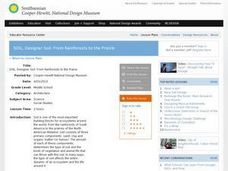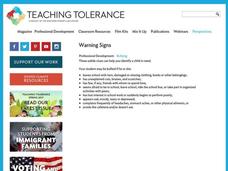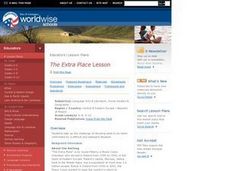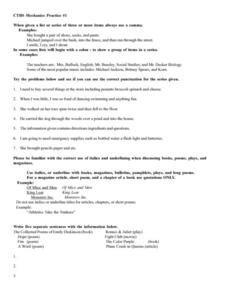Curated OER
Student Created Murals
Students, over the course of an acedemic quarter, paint a mural on a wall in their school. They decide on a theme, measure wall space, design images, decide on the amount of paint they need, designate teams, schedules, etc.
Curated OER
The History of Computers
Students study the people and inventions related to computers. They research famous people for each invention they created and create a timeline of the inventor and his inventions. They present an oral presentation about the person for...
National First Ladies' Library
King Tut and All That
Students study the field of Egyptology and archeology. They create an artifact for posterity and create a special edition that tells the story in words, maps, and pictures. They create a storyboard for a "comic book" edition of the story.
Curated OER
Ancient Greece Unit
Students complete a unit of study on Ancient Greece. In this Ancient Greece lesson, students complete 16 sets of activities to learn about Ancient Greece. Students finish with a comprehensive test over the unit.
Curated OER
The Four Religions of East Asia
Students compare and contrast the four main religions of Asia (Buddhism
Confucianism, Daoism, and Shinto). This lesson is intended for use in the middle school Social Studies classroom.
Curated OER
The Story of Magic: Centuries of Deception
Students examine the history of magic and the men and women who practice the art. The Story of Magic would be useful for classes on Religion, Culture, Mythology, Physics and Psychology. It is appropriate for middle school and high school.
Curated OER
Realism In Chinese Art
Students examine the artistic terms realism and idealism through the study of Chinese art and artifacts in this activity for the Social Studies classroom. Evaluation is accomplished through an in-class essay.
Curated OER
Education, Design & Empowerment: Part One
Students consider the connection between poverty and education. In this language arts and social studies lesson plan, students research primary and secondary sources in order to explore the relationship between education and poverty.
Curated OER
Water, Water Everywhere?
Students discover the relationship between water availability and population growth. They change variables in a computer model using a worksheet to guide their hypotheses and conclusions. In small groups they choose a country undergoing...
Curated OER
Soil, Designer Soil: From Rainforests to the Prairie
Students explore the role and importance of soil in the ecosystem. For this Science and Social Studies lesson, students complete an experiment using various kinds of soil and clay and then examine how soil has a direct impact on...
Curated OER
Making Stained Glass Windows
Students, in groups, research several European cathedrals from the Middle Ages. They design stained glass windows and decorate a school window with their design using black construction paper and cellophane.
Curated OER
Keep It Academic
Learners study various methods to learn about religion in the classroom. In this religion study lesson, students read and visit links to learn about various ways of teaching religion in schools. Learners learn the model world religion...
Curated OER
Warning Signs
Students identify the signs that someone is being bullied. In this school climate lesson, students discuss the provided list of signs that one is being bullied. Links are provided to other lessons about bullying.
Curated OER
Why do so Many Young People Carry Knives?
Students explore the rise in knife crimes in Great Britain. In this current events lesson, students research the noted websites to study knife laws, British trends, and knife history.
Curated OER
Whose Neighborhood is It? Whose America is This?
Pupils use electronic resources to study immigration issues, analyze immigration issues dealing with security, economics, lawfulness, culture, and human rights, and discuss possible solutions. Students then express their opinions by...
Curated OER
Who Is Who?
In this who is who worksheet, students draw a line from 6 people who are speaking on the sides of the worksheet to the word that best describes each one in the middle. Students answer 3 short answer questions at the bottom of the worksheet.
Curated OER
Cool Stuff I've Done!
Sixth graders reflect on the life experiences they have had and discover how those experiences may be classified on a resume. They begin brainstorming their life experiences and writing each one on a sticky note. At end of brainstorming...
Curated OER
In Congress Assembled: Continuity and Change in the Governing of the United States
Students interpret history using primary resources and secondary research. The Constitution is examined and changes are explained within the time period they were made.
Curated OER
The Extra Place
Students read and discuss the story of a Peace Corps volunteer's experiences in Poland. They read and write a response to the story, and participate in a class analysis about their own personal decision regarding the story.
Curated OER
The Extra Place Lesson
Students explore communication skills. In this Peace Corps lesson, students read "The Extra Place," by Susan Peters and discover Polish cultural traditions. Students consider how they would respond in a scenario that challenges their...
Curated OER
Ecology Explorers
Students create accurate, detailed map showing physical features, plants and trees, and other details of three school sites.
Discovering Gifts In Middle School
Multiple Intelligences Checklist
Invite your pupils to discover their strengths with a multiple intelligences assessment. They read through several pages of activities and check off the items that apply. Learners then tally up their scores to determine which of the...
Curated OER
CTBS Mechanics Practice #1
Use this CTBS mechanics worksheet to reinforce the correct use of commas, punctuation, italics, letter writing, and capitalization. Middle schoolers are given information on each of these areas and then answer a total of thirty multiple...
Curated OER
US Steel Gary Works: A Photographic Study
Learners formulate historical questions about the circumstances surrounding a photograph about the Gary Steel Works factories. They differentiate between historical facts and interpretation. They create a newspaper article about each photo.























